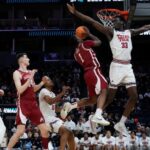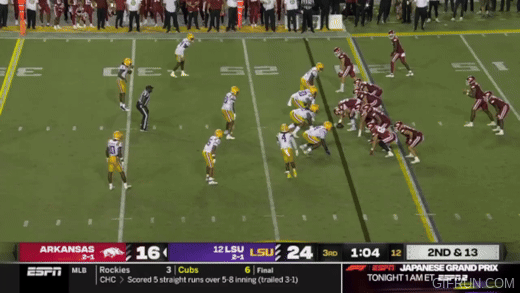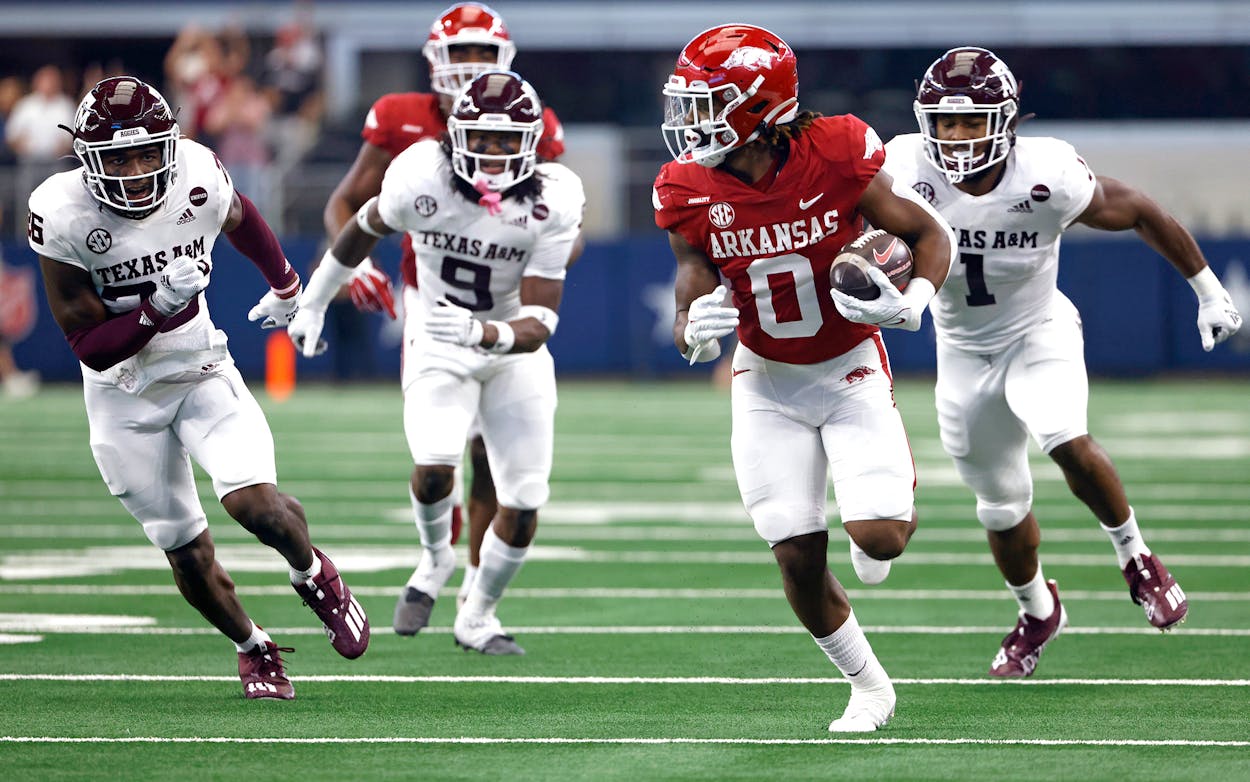Arkansas is hoping to build on a mostly-promising showing against LSU with a neutral-site game against Texas A&M in JerryWorld.
This is a prime opportunity for Arkansas to get a big win: Texas A&M starting QB Conner Weigman, who was having a nice year, is injured and out for the season. Critics have questioned Texas A&M’s team culture for a couple years now, this is a crossroads season for Jimbo Fisher, and A&M already has a big loss on the resume. If Arkansas manages to jump on the Aggies early, it’s going to be very interesting to see how they respond.
Meet the Aggies

Note: Consistency and Momentum metrics don’t become relevant until a team has played at least 4 FBS opponents. Arkansas has still played just three.
I think Texas A&M got written off after losing to Miami in Coral Gables, but that was probably a mistake. We’ve got Miami as the 5th-best team in our model, so the Aggies aren’t getting punished for a hard-fought loss. Jimbo’s team has rebounded from that loss and been merciless in two wins over hapless ULM and Auburn.

That’s not an optimistic projection, but there a few things to consider. Mainly, the model doesn’t consider injuries. Like at all. So the potential return of Rocket Sanders for Arkansas is not factored. Maybe more importantly, the impact of Texas A&M’s quarterback situation isn’t considered here either.
I also think it will be interesting to see what the Aggies do on defense against an offense with a pulse. They’ve looked great against New Mexico, ULM, and struggling Auburn, but Miami really lit them up (+20.2 Passing EPA, +0.63 EPA per pass, 35 noise-adjusted points, 8.2 yards per play). Our model thinks that some of Miami’s explosive passes may not be replicable (including the long one that sealed the game), so it’s giving the Aggies a slight boost there versus what happened in real life.
- Box Score Breakdown: Texas Tech 85, Arkansas 83

- Matchup Analysis: 3 Texas Tech

- Box Score Breakdown: Arkansas 75, St. John’s 66

When Texas A&M has the ball

Moving the ball hasn’t been an issue for the Aggies for a first time in a while under Jimbo Fisher. Bobby Petrino has this offense ranked 11th in EPA per play, 21st in success rate, and – thanks to help from good starting field position – 8th in creating scoring chances (that’s percentage of possessions that get a first down inside the opponent 40). The Aggies have no topline offensive weaknesses except that their run game is merely serviceable, rather than good.
Meet Max Johnson
Of course, all that’s up in the air now, with Conner Weigman suffering a season-ending foot injury in the win over Auburn. The Aggies have had some dismal QB luck, as this is the third straight season they’ve lost a starter to a season-ending injury, so the Hogs will face Max Johnson. Johnson has started games across four seasons for two different SEC West teams and is somehow only a redshirt sophomore. Here’s his career in a nutshell:
- 2020. Backed up TJ Finley at LSU, replacing him when he got hurt and making five starts. He wasn’t amazing but he showed good upside, enough for Finley to transfer to Auburn after the season.
- 2021. Opened the season as the starter for the Tigers. He was extremely productive against weak competition, but struggles in October caused him to be replaced by Garrett Nussmeier for the Arkansas game. He won back the starting job the following week and threw for 300 yards in each of LSU’s last two games.
- 2022. Transferred to Texas A&M, where he lost a battle for the starting job to Haynes King. King was horrible, though, and Johnson replaced him after just a couple weeks. He led the Aggies to a win over Arkansas but was mostly unimpressive and injured his hand a couple weeks later, allowing Weigman to take over.
- 2023. Failed to win back the starting job from Weigman, and opened as the backup. He stepped in against Auburn and started 5 of 5 for 93 yards and two touchdowns, putting the game away. He completed two of his final six passes.
Throughout his career, he’s been pretty consistent in his tendencies. First and foremost, he is a very accurate passer. He paced the three Aggie QBs last year in both raw accuracy (78%) and depth-adjusted accuracy (40%). That’s his strong suit.
Compared to Weigman, he’s a bit more timid, preferring shorter passes to taking deep shots (that does allow him to throw fewer interceptible passes). But his biggest issue is his tendency to hold onto the ball too long. Despite having the most time to throw last year among Aggie QBs (2.5 seconds per dropback), he suffered a massive 14.1% sack rate and 40.9% pressure rate, both among the worst of any SEC quarterback. Weigman also suffered a high pressure rate (about 37.1%) but both last year and this year, he has been significantly better at avoiding sacks.
Unfortunately for Johnson, the hiring of Petrino didn’t really help with pass protection. The Aggies were allowing Weigman to be pressured on 38.7% of his dropbacks this year – worst among SEC starters by a big margin. For comparison, KJ Jefferson is being pressured on 22.2% of his dropbacks, which is more in line with the SEC average of 23.3%.
The high pressure rate allowed the Aggie front combined with Johnson’s known issues in escaping pressure plus Petrino’s preference to attack down the field means you probably know what’s coming: Arkansas is about to blitz. A lot. Against teams that can generate a pass-rush, the success of the Petrino offense really just comes down to whether or not the quarterback can make hot reads and get the ball out fast enough. We saw that in last year’s Missouri State game, when Barry Odom tried to play vanilla defense and the Bears just shredded it. Forced to blitz, the Hogs recorded eight sacks, including four on the final three drives of the game.

If Johnson does get ample time to throw, he’s got a dominant one-two receiver punch in Evan Stewart and Ainias Smith. They’ve combined for 53 targets, 578 yards, and +35 EPA through the air in four games. The Hogs might can leave Dwight McGlothern in man coverage, but I’m not so sure on the other side. Johnson isn’t quite as accurate as Jayden Daniels, but Daniels really torched the Hogs when targeting Jaheim Singletary at the other cornerback spot.
The run game has been decent, and the Aggies seem to have made a change. Top tailback Amari Daniels really struggled against ULM, so they gave lead back carries Le’Veon Moss against Auburn, and he turned in a big performance (15 carries, 97 yards, +3 EPA, 60% success). Reuben Owens was also having a great game and until he fumbled and it was returned for Auburn’s only touchdown (hence his really bad EPA). As a team, the Aggies totaled 217 non-sack rushing yards on 31 carries with a solid 52% success rate. If the Aggie ground attack is rounding into form, that will make Johnson’s job easier.
When Arkansas has the ball

As mentioned above, A&M’s defense ranks 15th in predicted points allowed per drive, yet they are just 42nd in EPA per play. What gives? Well, our predicted points model aims to predict future performance, not describe past performance, so it tones down the impact of certain high-leverage plays. In particular, Texas A&M’s defense ranks just 75th in explosive play rate allowed, and Miami is responsible for most of that. Massive breakaway touchdowns – especially on third-and-long – aren’t necessarily predictive, so our model thinks the Aggie defense is probably better than what these numbers say. Unpredictable things happen sometimes.
Regardless, A&M’s defense is elite at getting off the field – one way or another. They don’t force many turnovers and they allow too many explosive plays, but they also don’t allow many successful plays generally, and are especially good when they have you in an obvious passing situation.
Arkansas posted a totally-unsustainable 60% passing downs success rate against LSU. To win this game, they’ll have to be much better on early downs and avoid third-and-long.

Arkansas’ run game seemed to find a bit of a groove against LSU, as the Hogs avoided running off tackle and went heavy on inside zones, allowing Rashod Dubinion to get downhill quickly and rely on the Hogs’ best run blockers. SEC Stat Cat had the Hogs running 10 inside zones (a season high), two inserts (a form of inside zone with a lead blocker), and 5 inside powers. That’s 17 runs right between the tackles. Most of the rest of the run game was quarterback draws, three outside zones (all on one drive, only one worked), a couple outside powers (including a Bash Counter Read, which Briles tried a few times last year but we hadn’t seen this year).
There’s good news here, as inside zone was basically the only thing that worked for Auburn’s poor offense last week. Per SEC Stat Cat, the Tigers dialed up 11 inside zones for 82 yards and seven successes. Check out this Bluff Read from Auburn…

… and now the same play from the Hogs:

I sort of expect the Hogs to go for a more simplified run game that leans in on these inside zones with a handful of power/counter runs mixed in. They might have some success against this Aggie defense.

We saw above how badly Miami torched with Aggie secondary, but no one else has been able to throw on Texas A&M. Of course, those quarterbacks were – checks notes – New Mexico’s Dylan Hopkins, ULM’s Jiya Wright, and Auburn’s Payton Thorne. Not exactly a murderer’s row. Thorne has been really awful this year and was replaced during the game.
In addition to being poor throwers, all three of the quarterbacks the Aggies have faced have been statues. Thorne, for example, has a sack-to-pressure ratio of almost 50%, which is the worst among SEC starters by an enormous margin. That means that on almost 50% of his dropbacks where he’s pressured, the defense ends up sacking him. Jefferson will be a lot harder to bring down, though the Aggie pass rush is no joke. A&M has some strong edge rushers, so the Hogs need to continue to use play action to freeze the rush and move the pocket as needed.
Keys to the Game
Sacks and pressures. Against a Jimbo Fisher quarterback, you have to get pressure. Against a Bobby Petrino offense, you have to get pressure. Against Max Johnson generally, you have to get pressure. A blowout win, a blowout loss, and everything in between will come down to Arkansas’ ability to make life absolutely miserable for the A&M quarterback. Blitzing risks giving up a big play, but failing to get pressure with a four-man rush is going to allow Johnson to shred the Razorback secondary.
Tackle in space. Arkansas’ team coverage hasn’t been bad this year, but man-to-man defense, particularly man-to-man when there’s a blitz, leaves defenders vulnerable if they can’t tackle in space. Petrino’s counter to everyone blitzing his offense is to make short throws to receivers on the move, hoping they can break tackles. Arkansas’ tackling in space has been suspect this season, especially against the more talented offenses of BYU and LSU. It’s going to be frustrating if Arkansas can get pressure on the quarterback but then can’t make tackles when he dumps the ball off to fast receivers.
More explosiveness. The biggest risk in hiring Dan Enos is his offense’s lack of explosive plays. You need explosive plays to beat teams more talented than you. Entering the LSU game, Arkansas ranked dead-last in the SEC in explosive play rate, with just 18 on the year. The Hogs had 9 against LSU, a season high. That’s why the game was even close. Unless Arkansas’ defense has a monster performance, I don’t think the offense can generate enough points to win this game by just grinding out long drives without big plays. The passing game is the best option for big plays, but if the offense can’t do it, then special teams needs to, with a punt or kickoff return.
Thanks for reading! Be sure to follow us on Twitter and on Facebook.
The latest from Fayette Villains, straight to your inbox
Enter your email to subscribe and receive new post alerts and other updates. You can unsubscribe at any time.
